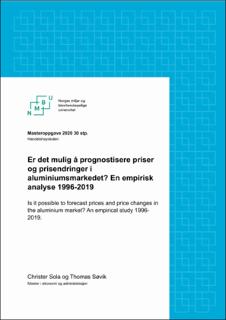| dc.contributor.advisor | Gjølberg, Ole | |
| dc.contributor.advisor | Steen, Marie | |
| dc.contributor.advisor | Fretheim, Torun | |
| dc.contributor.author | Sola, Christer Smerud | |
| dc.contributor.author | Søvik, Thomas | |
| dc.coverage.spatial | Norway, Oslo | en_US |
| dc.date.accessioned | 2020-09-30T11:16:57Z | |
| dc.date.available | 2020-09-30T11:16:57Z | |
| dc.date.issued | 2020 | |
| dc.identifier.uri | https://hdl.handle.net/11250/2680498 | |
| dc.description.abstract | Denne studien dreier seg om prognostisering av aluminiumsprisen ved London Metal Exchange. Studien skal undersøke om, og eventuelt hvilke, økonometriske prognosemodeller som prognostiserer aluminiumsprisen bedre enn den naive modellen uten drift i perioden 2015 til 2019. In-sample periodene er fra 1996 til 2014, 2001 til 2014 og 2009 til 2014 og vi benytter oss av måltallene MSE, MAE og MAPE, for å sammenligne modellene.
Studien undersøker de økonometriske prognosemodellene AR(p), ARIMA og VAR, i tillegg til at vi undersøker prognoseevnen til futureskontraktene. Futureskontraktene benyttet i denne studien er månedlige gjennomsnittlige futureskontrakter og kontinuerlig rullerende futureskontrakter. I AR(p)- og ARIMA- modellen benytter vi oss av den laggede aluminiumsprisen i henhold til modellene. Gjennom VAR-modellen undersøker vi prognoseevnen til et utvalg av futureskontrakter, andre metallpriser, aksjeindekser, valutakurser og makroøkonomiske indekser.
Konklusjonen på problemstillingen er at de nevnte modellene kan benyttes som prognose for aluminiumsprisen, men futureskontraktene vil kunne over- eller underprognostisere. Futureskontraktene prognostiserer ikke bedre enn den naive modellen basert på MSE, MAE eller MAPE. ARIMA-modellen prognostiserer bedre enn den naive modellen på MAE og MAPE, men ikke på MSE. Dette indikerer at ARIMA-modellen har enkelte større avvik på prognosen. AR(p)- og VAR-modellen prognostiserer bedre enn den naive modellen målt i MSE, MAE og MAPE. Dog viser resultatene at modellene kun gjør det minimalt bedre enn den naive modellen. Vi stiller oss derfor i tvil om det vil være økonomisk signifikant å benytte de mer avanserte modellene, i stedet for den enkle naive modellen uten drift. | en_US |
| dc.description.abstract | This thesis aims to forecast the aluminum price at the London Metal Exchange. The thesis evaluates whether, and if, econometric forecast models predict the aluminum price better than the random walk in the period from 2015 to 2019. The in-sample periods are from 1996 to 2014, from 2001 to 2014 and from 2009 to 2014, and we use MSE, MAE and MAPE as measurements to compare the models.
The thesis examines the econometric forecasting models AR(p), ARIMA and VAR, as well as the forecasting ability of futures contracts. The futures contracts used in this thesis are monthly average futures contracts and continuous rolling futures contracts. In the AR(p) and ARIMA model we use the lagged aluminum price according to the models. Through the VAR model, we evaluate the forecasting ability of a range of futures contracts, other metal prices, stock indices, exchange rates and macroeconomic indices.
The conclusion of this thesis is that the mentioned models can be used as a forecast for the aluminum price, but futures contracts may over- or under-estimate. The futures contracts do not predict better than the random walk model based on MSE, MAE or MAPE. The ARIMA model forecasts better than the random walk model on MAE and MAPE, but not on MSE. This indicates that ARIMA has some major deviations from the forecast. The AR(p) and VAR models predict better than the random walk model measured by MSE, MAE and MAPE. However, the results show that the models only do slightly better than the random walk model. Therefore, we doubt whether it will be economically significant to use the more advanced models, rather than the simple random walk model without drift. | en_US |
| dc.language.iso | nob | en_US |
| dc.publisher | Norwegian University of Life Sciences, Ås | en_US |
| dc.rights | Attribution-NonCommercial-NoDerivatives 4.0 Internasjonal | * |
| dc.rights.uri | http://creativecommons.org/licenses/by-nc-nd/4.0/deed.no | * |
| dc.subject | Aluminium | en_US |
| dc.subject | Råvaremarked | en_US |
| dc.subject | London Metal Exchange | en_US |
| dc.subject | Finans | en_US |
| dc.subject | Økonometri | en_US |
| dc.subject | VAR | en_US |
| dc.subject | ARIMA | en_US |
| dc.subject | AR | en_US |
| dc.subject | Futureskontrakter | en_US |
| dc.subject | Prognoser | en_US |
| dc.title | Er det mulig å prognostisere priser og prisendringer i aluminiumsmarkedet? : en empirisk analyse 1996-2019 | en_US |
| dc.title.alternative | Is it possible to forecast prices and price changes in the aluminium market? : an empirical study 1996-2019 | en_US |
| dc.type | Master thesis | en_US |
| dc.subject.nsi | VDP::Samfunnsvitenskap: 200::Økonomi: 210 | en_US |
| dc.source.pagenumber | 80 | en_US |
| dc.description.localcode | M-ØA | en_US |

